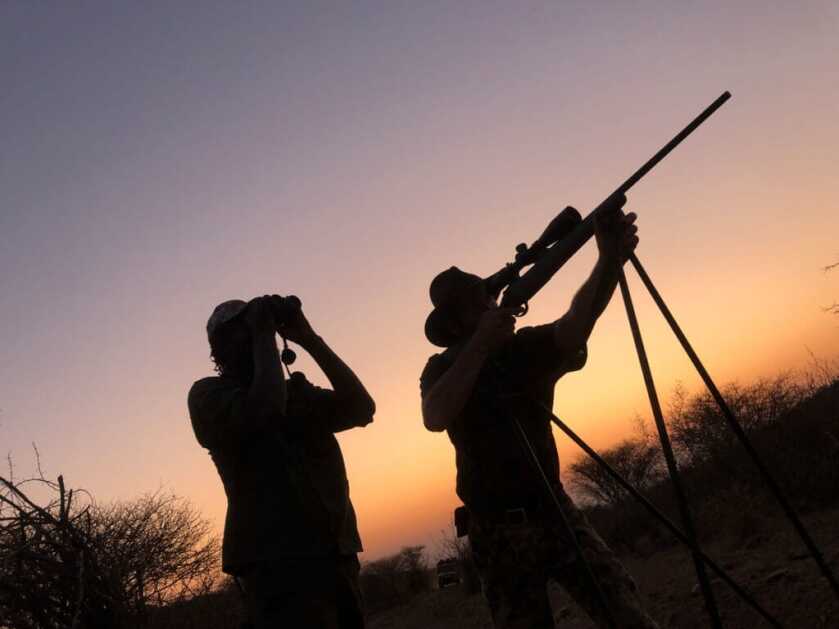
Dust rose in smoky whorls from underfoot as we stalked, faces to the wind; eyes intent for the flickering movement of eland legs through the underbrush. A heavy rifle cradled in the small hands of my 11-year-old son as he stalked, the intensity of the hunt strong upon his face. The eland, moving always into the wind, continued their steady walk and we followed, our black Professional Hunter Benjamin leading us like drifting shadows behind the herd. Finally, they cleared the brush, trailing in a line across a savanna-like camelthorn flat. An old cow walked behind, age showing in the movement of rib and hipbones under taut skin. Benjamin moved forward quickly, set the small shooting sticks to command a long lane through the trees, and waited for Josiah’s shot. Steady upon the sticks, legs spread wide, Josiah watched the old eland through the riflescope as she moved through the veldt. She stopped just in time, her shoulder showing at the far left edge of the lane. Dust puffed from the exact center of her shoulder, the herd bolted, and the old eland lay still in the Kalahari sand.
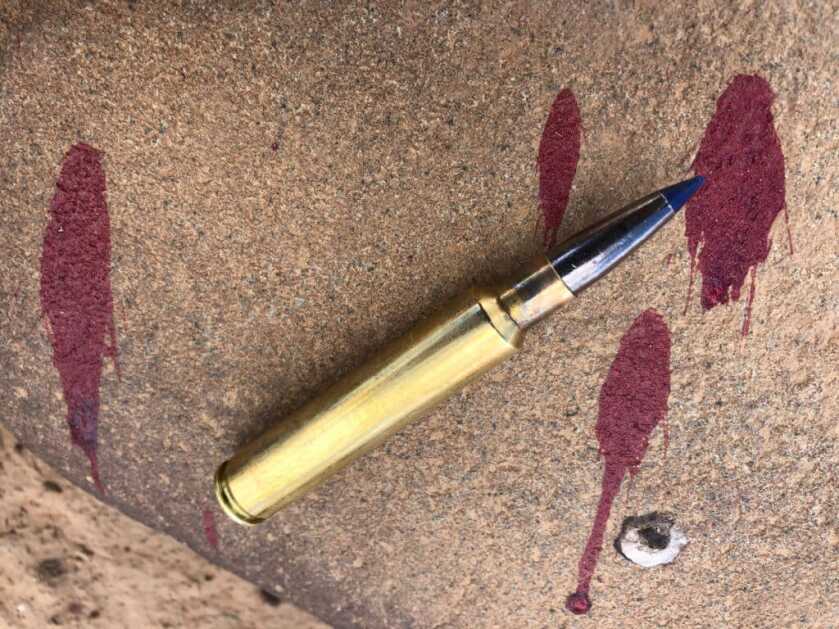
BULLET PERFORMANCE
Bullet design and performance is a favored (and occasionally heated) discussion wherever hunters gather. Debates rage, stories are told, and facts presented. Which brings us to the question: What is good bullet performance?
To perform well a bullet must expand (mushroom) rapidly, but not too rapidly, throughout a wide velocity range. It must penetrate deeply to access vital organs and tissues; which demands good weight retention for sustained energy and momentum. And it must be capable of penetrating through heavy bone without coming apart, leaving enough weight and mass to carry on through vitals and accomplish its purpose. Last but not least, it must be accurate and aerodynamic.
There are many good hunting bullets on the market. All possess at least one of the attributes outlined above, some possess several, and a select few possess most.
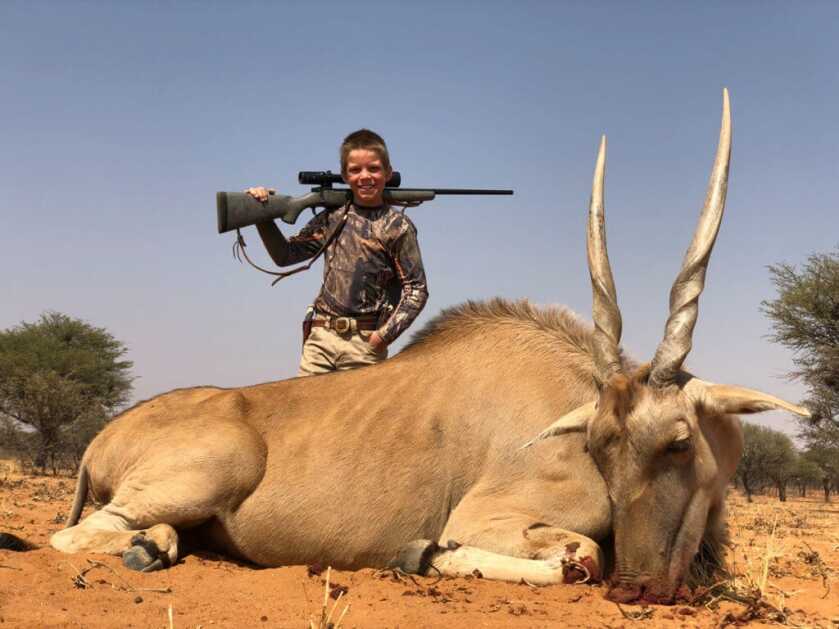
TEST MEDIUM
It’s easy to test hunting bullets for accuracy and aerodynamics. It’s even easy to test bullets in ballistic gelatin that simulates soft tissue. But it’s nigh impossible to perform factory testing against the combined characteristics of the hide, bone, and soft tissue that a bullet can be expected to encounter. The truest test medium is shooting actual big game in actual hunting scenarios. But where can you go to hunt lots of animals of differing size and bone structure? Africa.
NEW 155 GRAIN 7MM/.284 EDGE TLR
I was recently privileged to spend 11 days hunting plains game in Africa with the latest iteration of Federal’s new Edge TLR (Terminal Long Range) bullet. It’s .284 inches (7mm) in diameter, weighs 155 grains, and sports a G1 BC of .610. The Edge TLR is the designed-for-long-range descendent of Federal’s legendary Trophy Bonded Bear Claw and the Trophy Bonded Tip line. The aft portion of the bullet is solid copper and is almost impossible to fragment or destroy. The forward portion of the bullet is lead-filled and bonded, designed to expand aggressively while still holding together and maintaining weight. Federal’s Slipstream polymer tip tops off the assembly. It’s a beautifully designed, highly aerodynamic projectile.
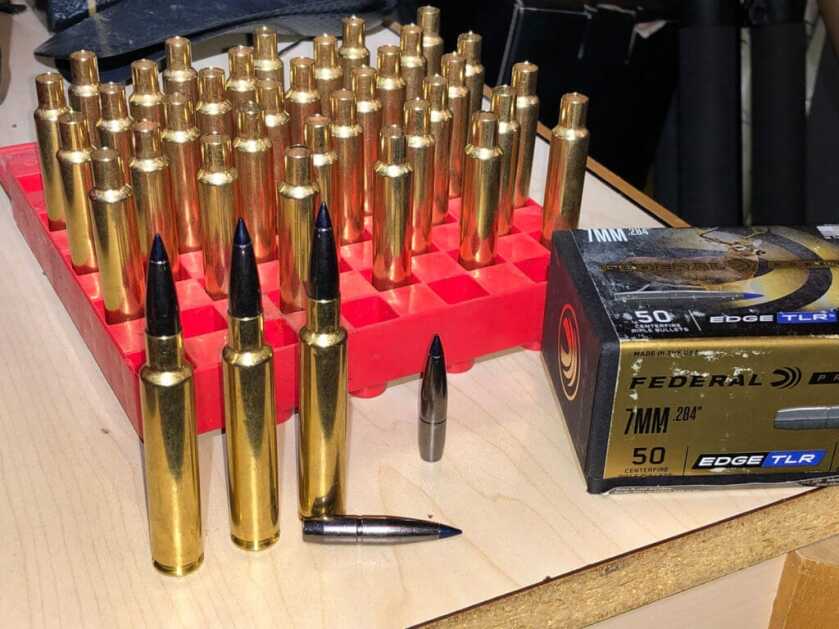
It’s worth noting at this point that the EDGE TLR was engineered for superb terminal performance and aerodynamics, but it’s not touted by Federal to possess match-grade accuracy. Groups from my Nosler Liberty M48 averaged 1.17 inches at 100 yards. Is that good enough? Read on.
I handloaded my bullets over 60 grains of H4831SC in Nosler .280 Ackley Improved brass, backed by Federal Gold Medal large rifle primers. Velocity averaged exactly 3,000 feet per second (FPS) at the muzzle. Between Josiah and I, we harvested eight species with the ammo, ranging from tiny steenbok to massive eland. Here are short stories of each, complete with informal autopsy and performance observations.
STEENBOK
This was the first animal I harvested with the new bullet, and the tiny antelope presented no challenge to the bullet’s penetrative ability. Bullet placement was another story, as the little buck only offered a 222-yard shot – which is tough to make on a vital area the size of a baseball. But make it I did, dropping the old steenbok in its tracks with one well-centered shot. The impact was in the crease behind the shoulder, with the exit exactly opposite and about one inch in diameter.

SPRINGBUCK
My second animal happened to be a cull black springbuck. We surprised him on a plain, and before we got set up he’d stretched the distance to 270 yards. My shot took him at a very slight quartering-away angle, entering behind the shoulder and exiting center shoulder opposite. The buck sprinted roughly 60 yards, leaving a massive blood trail.
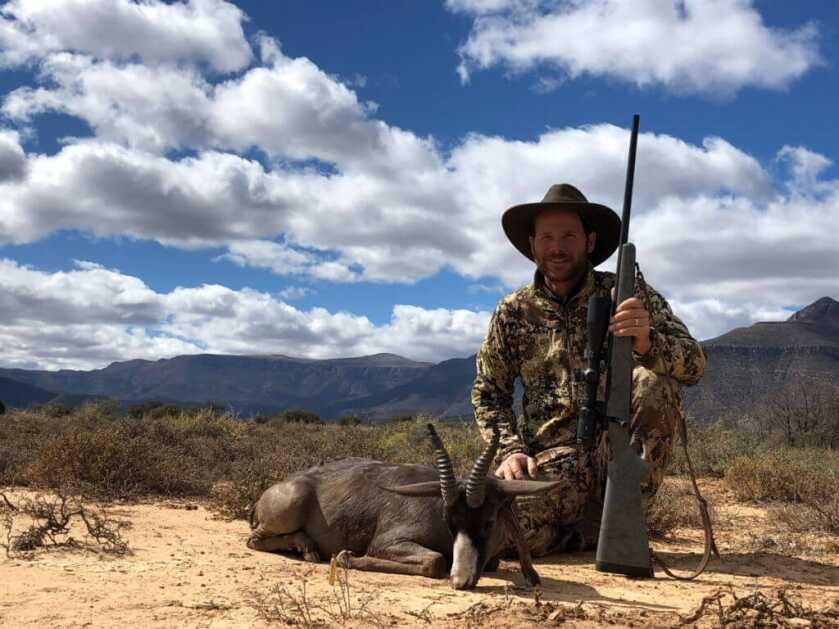
BABOON
This hunt happened fast and was one of my favorites of the whole trip. We’d been looking for a troop of baboons that had been raiding feed from the farm’s lambing pens. While grinding our way up a rough mountain road we spotted the troop making a break for a rocky ledge on the opposite side of a canyon. They were pretty far off already and busy stretching the distance even more as I ranged the lead male with my Zeiss Victory RF binocular, dialed my scope to the ballistic solution it provided, and settled in for the shot. He stopped at 413 yards and sat smugly, apparently believing he’d outrun the danger. My shot took him through the chest, very effectively convincing him to leave the lambing pens alone. I was stoked, and beginning to believe that my rifle/scope/bullet combination was pretty deadly medicine.
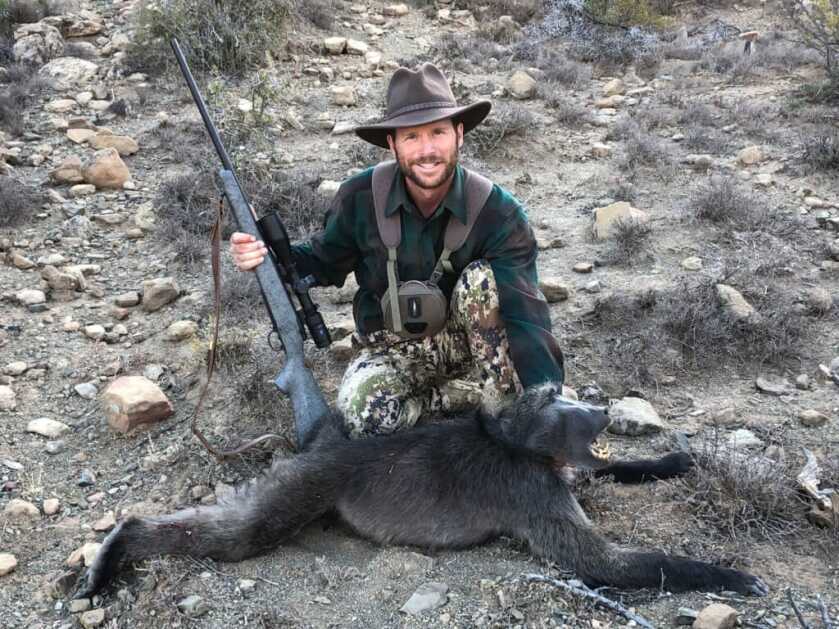
GEMSBOK (ORYX)
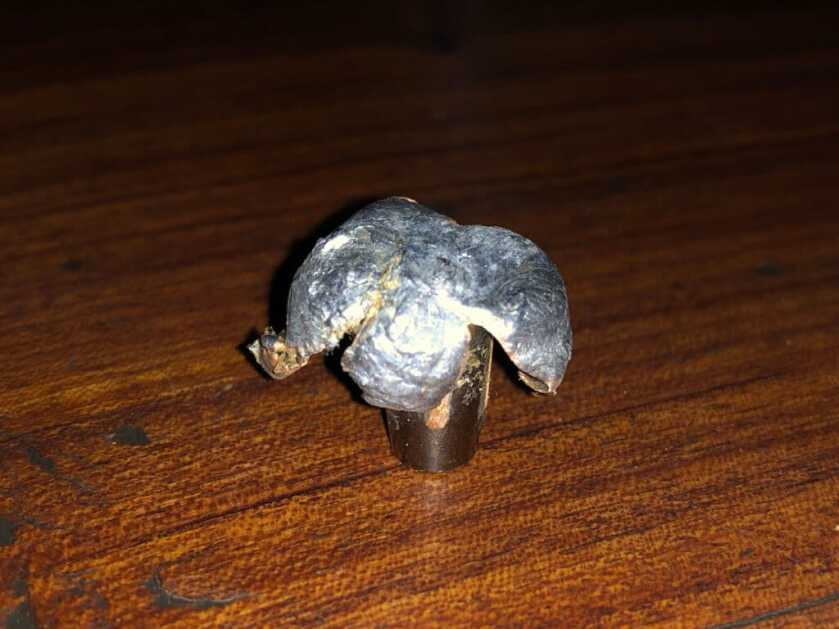
My first shot on an animal of significant size and toughness came while stalking the sands of the Kalahari. Just before dark, we found an old cull cow oryx, stalked within range, and I took the 245-yard shot. She made it roughly 40 yards before piling up. Now, oryx are known for being tough and very hard to kill; in fact, I personally am of the opinion that they are as hard or harder to stop than a big bull elk while being only 1/3rd the size. My shot on this animal was the least perfect of the trip, entering just ahead of the crease behind the shoulder and angling rearward to stop under the hide just over the second-to-last rib. The heart and lungs of most African plains game reside much further forward than our American deer and elk’s vitals, making it important to place your bullet through the shoulder rather than behind the shoulder. I failed to recognize that this oryx was quartered toward me, and so my bullet placement was less than ideal. Even so, the animal went down rapidly to the single shot.
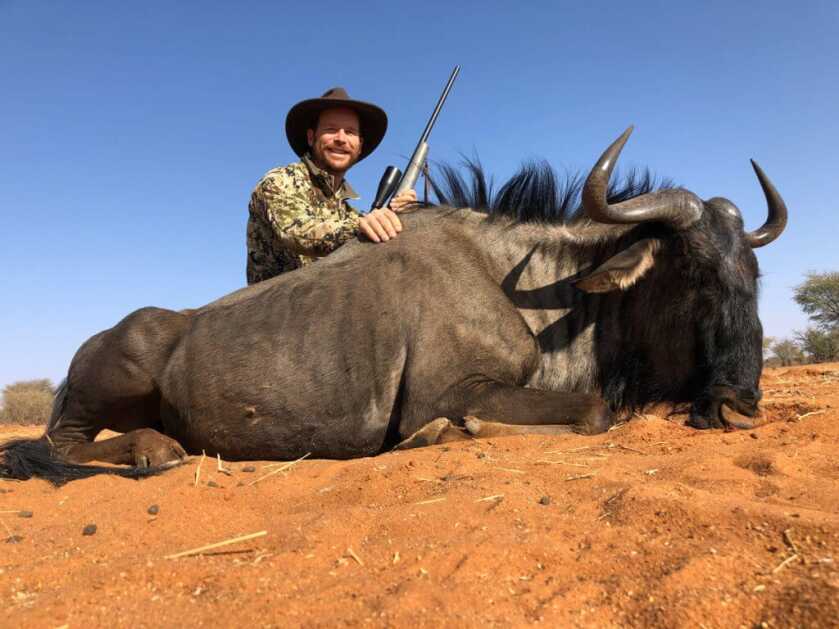
BLACK WILDEBEEST
Another tough animal, the black wildebeest has a reputation for being hard to kill. My opportunity at a big bull came at 270 yards, flat on my belly in the Kalahari sand. The bull had seen us and was quartered toward me hard, giving me only a narrow shot angle at the point of his shoulder. I rested my rifle over my binocular and squeezed the trigger. Dust puffed from the bull’s shoulder and the herd erupted, disappearing in a cloud of dust. The bull ran about 70 yards and went down, but struggled back to his feet as we approached. A thick screen of brush all but obscured him as I tried a follow-up shot. Turns out the follow-up shot was unnecessary, as my first shot was spot on target, breaking the shoulder where it entered before traveling through both lungs and stopping somewhere in the bull’s opposite flank.

OSTRICH
“Yes, you can shoot an ostrich.” I was surprised to hear my PH’s heavily accented assent, but not slow to accept it. “Okay, I’d love to, should the opportunity present.” Unsure about shot placement, I asked where to aim at an ostrich. He explained, leaving me with vague concepts of shooting at wing butts, breaking a leg down, and where a Texas heart shot was located on 300-pound birds.
Just at dusk, an ostrich ran across the dusty road ahead of our land cruiser as we traveled toward the lodge. It stopped about 100 yards distant, so I jumped off the truck, settled my rifle into the shooting sticks, and tried to squeeze the trigger on the big brown body. Before I managed the bird was off, running through brush so high I couldn’t see its body, just the head and neck periscoping away across the veldt. A grunt from the PH signified that the jig was up, but I kept my crosshairs on the bird and it finally stopped, way out across the brush, only head and neck showing. I received an affirmative when I asked if I could shoot at the head, so not knowing the precise range I held on the bird’s noggin, reasoning that my bullet might hit the head or drop into the neck somewhere. The trigger broke and a loud pop coincided with the disappearance of the ostrich head and exclamations of surprise from my PH and tracker. I had just shot that big old bird through its little tiny head/neck at 275 yards. I was now convinced that my rifle/scope/bullet combination was fully invincible.

ZEBRA
Not possessing a toughness reputation akin to that of oryx or wildebeest, zebra are nonetheless big, heavy-boned animals. Bullets must be tough and penetrate deeply in order to do their job well. One early morning we spotted a small herd of mountain zebra high on the side of a steep, rocky, brush-covered ridge. Several hours of stalking later I waited, rifle across the shooting sticks, for a zebra to offer a shot through the brush. Finally, it came, a tiny 200-yard window to the animal’s quartered-on shoulder. My shot broke the heavy bone at the point of the shoulder and angled through lungs, heart, and innards before stopping in the front edge of the opposite hindquarter. Much to my chagrin, we were unable to find the bullet, but we did follow its remarkable path through some 45-plus inches of zebra bone and tissue. The animal was down in less than 30 yards.
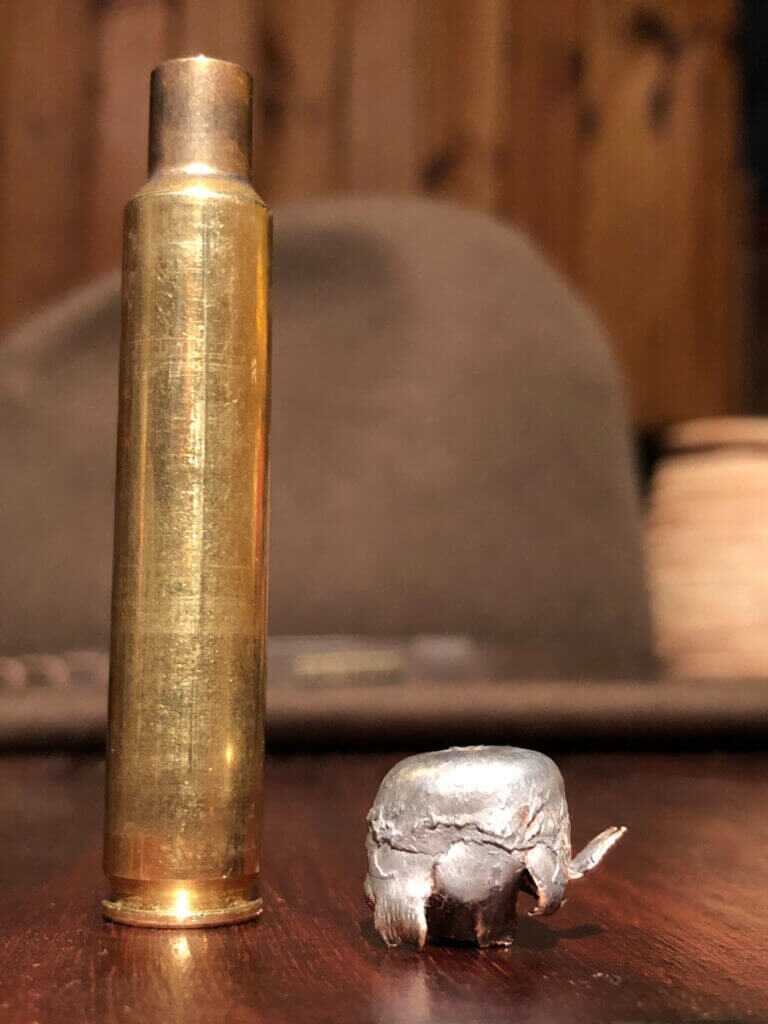
ELAND
The biggest of all African antelope species, a cull cow eland was to be my final test for the new 155-grain TLR bullet. It was my 11-year-old son Josiah’s turn to hunt, so he put away his 6.5 Creedmoor and took up my .280 A.I. He made a perfect 200-yard shot, and it turned out to be my favorite hunt of the entire trip. I’ve penned the story in the opening paragraph. I was shocked at how quickly the eland was down; she only made it 10 yards and went down immediately. The bullet took her in the center of the heavily-muscled shoulder, passed through both lungs and the large arteries atop the heart, broke the opposite shoulder bone just above the joint, and came to rest under the skin. Impressive performance.
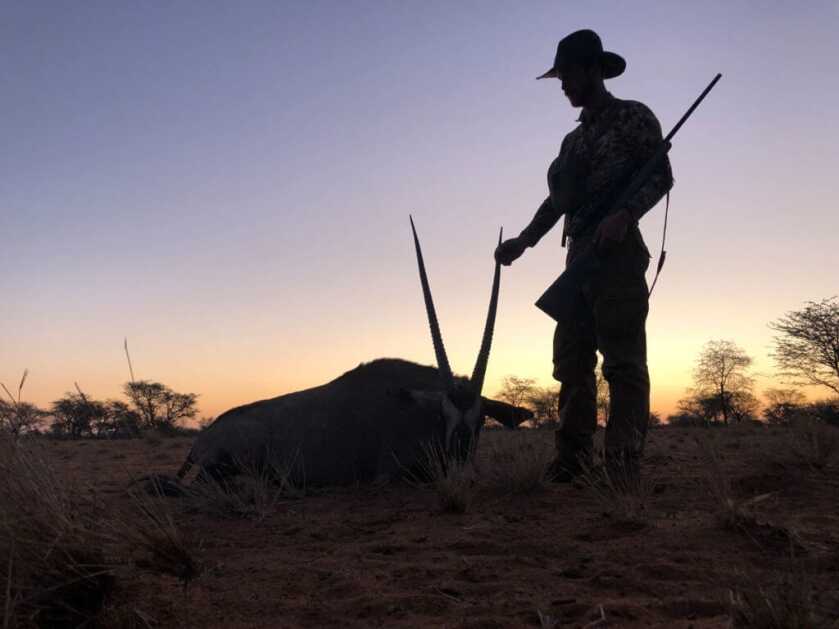
CONCLUSION
We harvested eight animals in Africa from the tiny steenbok to the massive eland with my .280 Ackley Improved and Edge TLR bullets. All were one-shot kills. Bullet performance in every case was very, very good. I would be glad to use it again on anything short of brown bear and Cape buffalo.


Been killing elk and mule deer with 7mm Mag handloads since the mid 70’s. Nosler Partition and Ballistic Tips have been my Bullets of choice. Always interested in better accuracy and performance. How about this bullet for my 7 Mag? My rifle is a Brown Precision, remember those guys, with a pre-64 Win Action, Canjar Set Trigger, old model Leupold 6-20X50 scope. My hunting companions have tagged the old rifle as “Darth”, which attest to it’s lethal nature. Barrel is on its last leg and needs to be replaced, but I don’t have the heart to separate it from the rest. At 75 I’m not sure a new LR Hunting rifle is in my future. Thought I might play with this .284 bullet, if it will work. Thanks.
Congratulations on such a successful hunt! The 155 gr. is a bit heavy for caliber. Would you recommend a twist rate faster than 1:10? What was the twist rate of your .280 AI rifle?
No the 155 isn’t heavy for Caliber the 140-168 is ideal in the 7mm bore
Hornady 162 eldx is another great bullet in the 280 AI
That sounds like a pretty hot load. My 280 AI loaded with 150 grain Partitions shoots 2850 fps, and shows slightly flattened primers. I could squeeze another 50 fps out of it, but the average group is .636″ at 100 yards. I’ve tried TTSX and LRX bullets, as well. I will give these Federal 155’s a try. Thanks for the real world analysis.
The partition and the elr are, toralkt different DESIGHN
My 280 ackley, (original chambering NOT THE NEW SAMMII SPEC) with A 26 inch bartlien 5r 1:8 twist with 58.3grns if powder Peterson case WILL.PUSH THE 155 tlr @3058 (I can get 3069) but accuracy wise 3058 is, excellent
I took a, 6×6 bull elk here in montana with this load @ 573 yrds, hit him dead center in theright shoulder took. Out the lungs heart destroyed the left shoulder upon exit drt 1shot
Would ‘ this bullet work for 7mm/08
Sure would!
You bet it would!